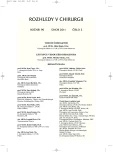-
Medical journals
- Contact
Vascular Complications in Transcatheter Aortic Valve Implantation in IKEM
Authors: J. Malý; M. Želízko 1; I. Netuka; B. Janek 1; O. Szárszoi; T. Kotulák 2; T. Marek 1; J. Pirk
Authors‘ workplace: Klinika kardiovaskulární chirurgie IKEM, Praha, přednosta: prof. MUDr. Jan Pirk, DrSc. ; Klinika kardiologie IKEM, Praha, přednosta: prof. MUDr. Josef Kautzner, CSc. 1; Klinika anesteziologie a resuscitace IKEM, Praha, přednosta: MUDr. Tomáš Kotulák 2
Published in: Rozhl. Chir., 2011, roč. 90, č. 2, s. 106-110.
Category: Monothematic special - Original
Overview
Aim:
Retrograde transfemoral arterial approach is the most common technique of transcatheter aortic valve implantation. Diameter of available catheters is the limiting factor for percutaneous usage. We currently use 18 French third generation Medtronic Core Valve system. We retrospectively analyzed procedure related complications in our patient cohort.Material and methods:
transcatheter aortic vale implantation with 18 French Medtronic Core Valve was performed in 35 patients (23 females, 12 males) in between 12/2008 and 7/2010.Results:
Mean age was 81.4 ± 6.1 years (range 69–92), mean logistics EuroSCORE was 19.3 ± 8.9% (range 8–42), mean aortic valve gradient 59.8 ± 19.8 mm Hg (range 30–86 mm Hg (mean indexed aortic valve area 0.37 ± 0.11 cmKey words:
TAVI – surgical site complications – vascular complications – surgical cut down
Sources
1. Ross, J. Jr., Braunwald, E. Aortic stenosis. Circulation, 1968; 38(1 Suppl): 61–67.
2. Cribier, A., Eltchaninoff, H., Bash, A., et al. Percutaneous transcatheter implantation of an aortic valve prosthesis for calcific aortic stenosis: first human case description. Circulation, 2002; 106 : 3006–3008.
3. Grube, E., Schuler, G., Buellesfeld, L., et al. Percutaneous aortic valve replacement for severe aortic stenosis in high-risk patients using the second - and current third-generation self-expanding CoreValve prosthesis: device success and 30-day clinical outcome. J. Am. Coll. Cardiol., 2007; 50 : 69–76.
4. Dewey, T. M., Brown, D. L., Das, T. S., et al. High-risk patients referred for transcatheter aortic valve implantation: management and outcomes. Ann. Thorac. Surg., 2008; 86 : 1450–1456 [discussion 1456–1457].
5. Vahanian, A., Alfieri, O., Al-Attar, N., et al. Transcatheter valve implantation for patients with aortic stenosis: a position statement from the European Association of Cardio-Thoracic Surgery (EACTS) and the European Society of Cardiology (ESC), in collaboration with the European Association of Percutaneous Cardiovascular Interventions (EAPCI). Eur. Heart J., 2008; 29 : 1463–14670.
6. Webb, J. G., Pasupati, S., Humphries, K., et al. Percutaneous transarterial aortic valve replacement in selected high-risk patients with aortic stenosis. Circulation, 2007; 116 : 755–763.
7. Masson, J.-B., Al Bugami, S., Webb, J. G. Endovascular balloon occlusion for catheter-induced large artery perforation in the catheterization laboratory. Catheter Cardiovasc. Interv., 2009; 73 : 514–518.
8. Berry, C., Cartier, R., Bonan, R. Fatal ischemic stroke related to non permissive peripheral artery access for percutaneous aortic valve replacement. Catheter Cardiovasc. Interv., 2007; 69 : 56–63.
9. Webb, J. G., Altwegg, L., Boone, R. H., et al. Transcatheter aortic valve replacement: impact on clinical and valve-related outcomes. Circulation, 2009; 119 : 3009–3016.
10. Tuzcu, M. E. Transcatheter aortic valve replacement malposition and embolization: innovation brings solutions also new challenges. Catheter Cardiovasc. Interv., 2008; 72 : 579–580.
11. Walther, T., Simon, P., Dewey, T., et al. Transapical minimally invasive aortic valve implantation: multicenter experience. Circulation, 2007; 116: I240–245.
12. Ruge, H., Lange, R., Bleiziffer, S., et al. First successful aortic valve implantation with the CoreValve ReValving System via right subclavian artery access: a case report. Heart Surg. Forum, 2008; 11: E323–324.
13. Bauernschmitt, R., Schreiber, C., Bleiziffer, S., et al. Transcatheter aortic valve implantation through the ascending aorta: an alternative option for no-access patients. Heart Surg. Forum, 2009; 12: E63–64.
14. Walther, T., Dewey, T., Borger, M. A., et al. Transapical aortic valve implantation: step by step. Ann. Thorac. Surg., 2009; 87 : 276–283.
15. Piazza, N., Wenaweser, P., van Gameren, M., et al. Relationship between the logistic EuroSCORE and the Society of Thoracic Surgeons Predicted Risk of Mortality score in patients implanted with the CoreValve ReValving system – a Bern-Rotterdam Study. Am. Heart J., 2010; 159 : 323–329.
16. Webb, J. G., Altwegg, L., Masson, J. B., et al. A new transcatheter aortic valve and percutaneous valve delivery system. J. Am. Coll. Cardiol., 2009; 53 : 1855–1858.
Labels
Surgery Orthopaedics Trauma surgery
Article was published inPerspectives in Surgery

2011 Issue 2-
All articles in this issue
- Simultaneous Transplantation of the Kidney and the Islets of Langerhans
- Liver Transplantation in Patients with Portal Vein Thrombosis
- Early Biliary Complications Following Liver Transplantation
- First Czech and Slovak Domino Liver Transplantation
- Development of Pancreas Transplantation Surgical Techniques in IKEM
- Immunosuppression Following Venous Allografts Transplantations – The Authors’ experience
- Effect of Biological Glues on Vascular Wall in an Experimental Model of Aortic Dissection
- Technique of Implantation and Experience with Temporary Mechanical Cardiac Support in Right Ventricular Failure
- Outcomes of Combined Mitral Valve Repair Surgery and Aortic Valve Replacement in IKEM Praha
- Cardiosurgical Procedures in Patients Refusing Blood Transfusions: IKEM Outcomes
- Vascular Complications in Transcatheter Aortic Valve Implantation in IKEM
- Perspectives in Surgery
- Journal archive
- Current issue
- Online only
- About the journal
Most read in this issue- Early Biliary Complications Following Liver Transplantation
- Outcomes of Combined Mitral Valve Repair Surgery and Aortic Valve Replacement in IKEM Praha
- Cardiosurgical Procedures in Patients Refusing Blood Transfusions: IKEM Outcomes
- Development of Pancreas Transplantation Surgical Techniques in IKEM
Login#ADS_BOTTOM_SCRIPTS#Forgotten passwordEnter the email address that you registered with. We will send you instructions on how to set a new password.
- Contact

